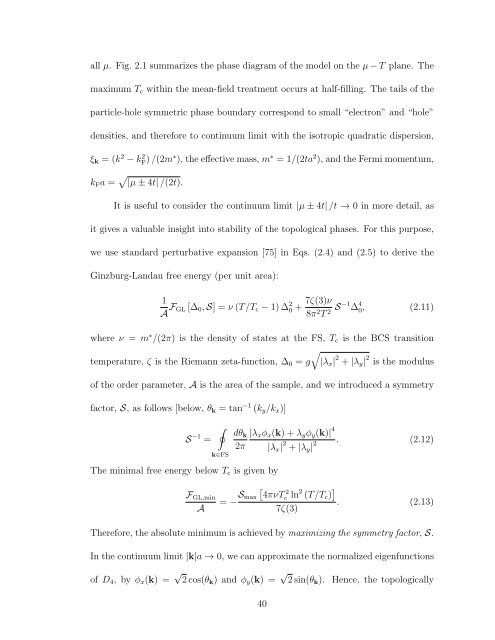ABSTRACT - DRUM - University of Maryland
ABSTRACT - DRUM - University of Maryland
ABSTRACT - DRUM - University of Maryland
Create successful ePaper yourself
Turn your PDF publications into a flip-book with our unique Google optimized e-Paper software.
all µ. Fig. 2.1 summarizes the phase diagram <strong>of</strong> the model on the µ − T plane. The<br />
maximum T c within the mean-field treatment occurs at half-filling. The tails <strong>of</strong> the<br />
particle-hole symmetric phase boundary correspond to small “electron” and “hole”<br />
densities, and therefore to continuum limit with the isotropic quadratic dispersion,<br />
ξ k = (k 2 − k 2 F ) /(2m∗ ), the effective mass, m ∗ = 1/(2ta 2 ), and the Fermi momentum,<br />
k F a = √ |µ ± 4t| /(2t).<br />
It is useful to consider the continuum limit |µ ± 4t| /t → 0 in more detail, as<br />
it gives a valuable insight into stability <strong>of</strong> the topological phases. For this purpose,<br />
we use standard perturbative expansion [75] in Eqs. (2.4) and (2.5) to derive the<br />
Ginzburg-Landau free energy (per unit area):<br />
1<br />
A F GL [∆ 0 , S] = ν (T/T c − 1) ∆ 2 0 + 7ζ(3)ν<br />
8π 2 T 2 S−1 ∆ 4 0, (2.11)<br />
where ν = m ∗ /(2π) is the density <strong>of</strong> states at the FS, T c is the BCS transition<br />
√<br />
temperature, ζ is the Riemann zeta-function, ∆ 0 = g |λ x | 2 + |λ y | 2 is the modulus<br />
<strong>of</strong> the order parameter, A is the area <strong>of</strong> the sample, and we introduced a symmetry<br />
factor, S, as follows [below, θ k = tan −1 (k y /k x )]<br />
S −1 =<br />
∮<br />
k∈FS<br />
dθ k<br />
2π<br />
The minimal free energy below T c is given by<br />
F GL,min<br />
A<br />
|λ x φ x (k) + λ y φ y (k)| 4<br />
|λ x | 2 + |λ y | 2 . (2.12)<br />
[ = −S<br />
max 4πνT<br />
2<br />
c ln 2 (T/T c ) ]<br />
. (2.13)<br />
7ζ(3)<br />
Therefore, the absolute minimum is achieved by maximizing the symmetry factor, S.<br />
In the continuum limit |k|a → 0, we can approximate the normalized eigenfunctions<br />
<strong>of</strong> D 4 , by φ x (k) = √ 2 cos(θ k ) and φ y (k) = √ 2 sin(θ k ). Hence, the topologically<br />
40
















